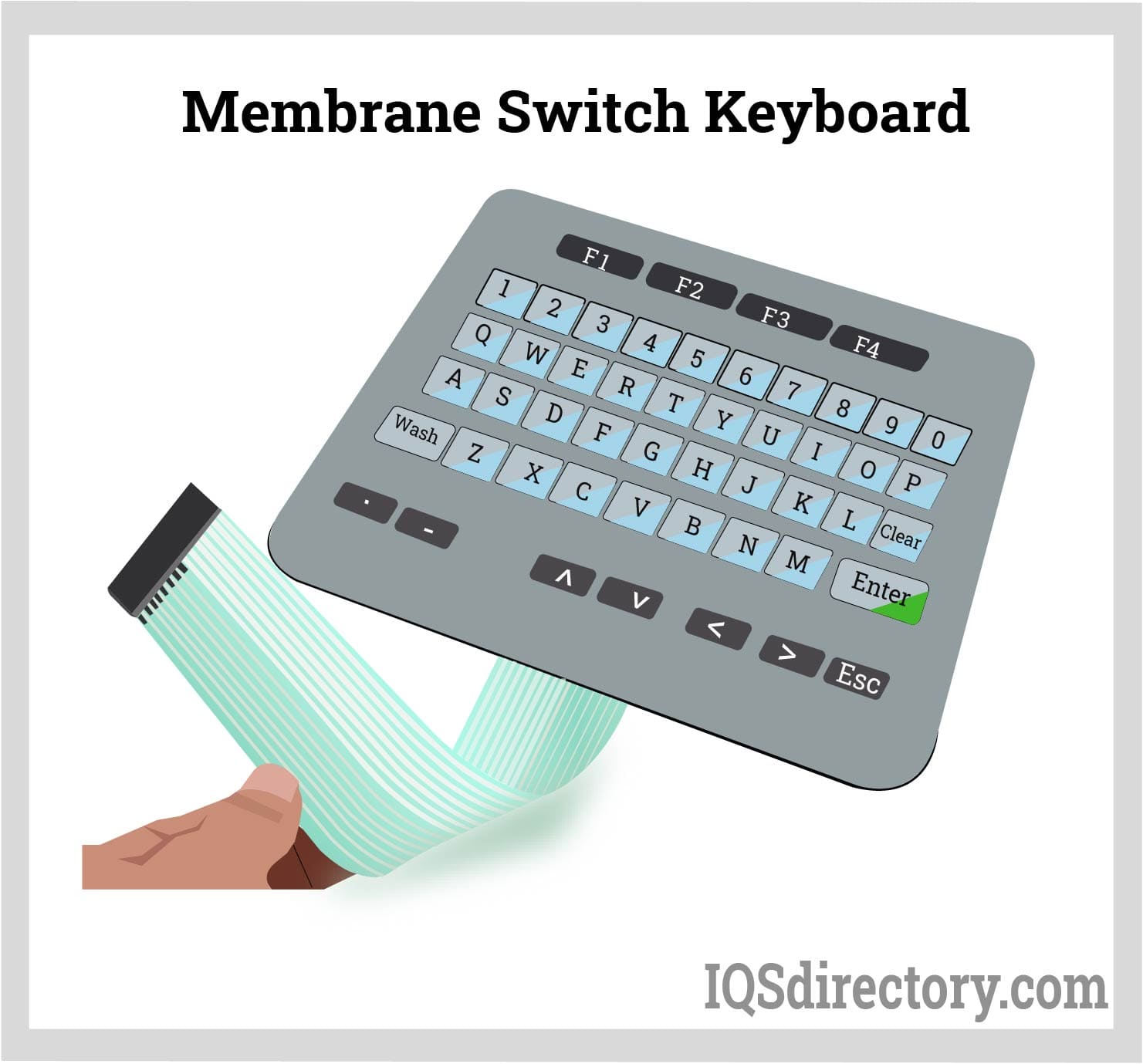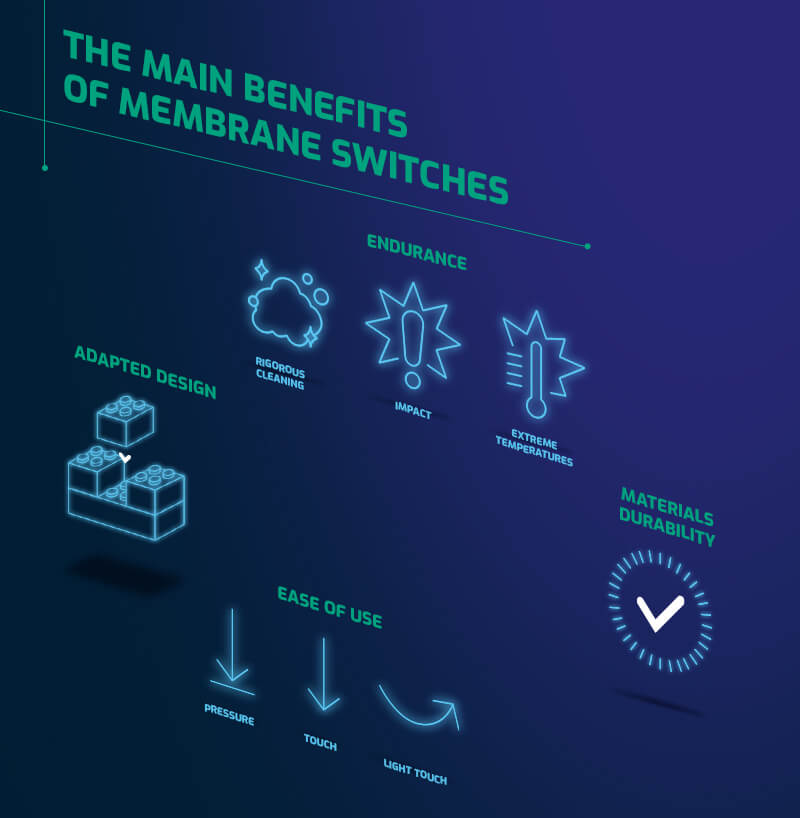The Production Process Behind Membrane Switch Over: What You Required to Know
The manufacturing process behind membrane layer switches over combines careful design, material option, and quality assurance. It starts with comprehending the details of membrane button layout and proceeds through numerous phases, including material choices and printing methods. Each phase plays a necessary role in ensuring capability and resilience. The complexities of layer building and construction and the strenuous testing standards may disclose understandings that are not immediately noticeable. What exists past these fundamental components?
Understanding Membrane Switch Over Design
Although membrane buttons may show up easy at initial look, their layout includes complex considerations that guarantee capability and durability. The layout procedure starts with a detailed understanding of customer needs, consisting of the user interface's intended application and environmental elements. Ergonomics is a crucial element, as the layout must facilitate ease of usage while making sure that responsive comments satisfies user expectations.Moreover, the layering of components, such as graphic overlays, sticky layers, and conductive traces, should be precisely crafted. membrane switch. This split setup not only affects the button's responsiveness yet additionally affects its durability. Attention is provided to the securing methods employed to shield against dampness and dirt, which could endanger efficiency. Additionally, layout factors to consider reach looks, where color pattern and aesthetic clarity boost individual experience. Ultimately, the layout of membrane layer changes equilibriums performance, user experience, and durability, making certain that they satisfy the needs of different applications efficiently
Materials Utilized in Membrane Change Manufacturing
When choosing materials for membrane button production, it is necessary to contemplate both efficiency and durability. The main products include polyester and polycarbonate movies, which provide versatility and strength. These films are usually coated with sticky to guarantee appropriate bonding to substratums. Conductive inks, generally composed of silver or carbon, are important for creating electrical links within the button, allowing for trustworthy operation.Additionally, a protective layer, such as a difficult layer, is frequently related to boost scratch resistance and durability. The option of backing product, such as acrylic or foam, can considerably affect the switch's responsive feeling and overall user experience. Different environmental factors, consisting of temperature level and moisture, ought to lead product selection to ensure peak efficiency in certain applications. Inevitably, the appropriate combination of products adds to the membrane switch's functionality and lifespan, making informed selections crucial for makers.
The Printing Process: Creating Video and Text
The printing process in membrane switch manufacturing plays a significant role in generating top notch graphics and message. Numerous visuals layout methods are utilized to ensure visual appeal and performance, while mindful ink choice techniques are necessary for toughness and efficiency. Comprehending these elements is fundamental for achieving best lead to membrane layer button style.
Graphic Design Techniques
Graphic style strategies play a vital function in the printing procedure of membrane buttons, as they define how graphics and message will ultimately show up on the end product. Efficient graphic design includes the critical usage of shades, fonts, and designs to boost readability and visual charm. Designers frequently make use of vector graphics for scalability, guaranteeing that photos continue to be sharp at numerous dimensions. In addition, interest to contrast and alignment is important, as it affects customer interaction and aesthetic top quality. The consolidation of branding components, such as logos, need to be handled with care to preserve brand name integrity. Generally, thoughtful graphic style strategies add significantly to the functionality and appearance of membrane layer buttons, affecting individual experience and item efficiency.
Ink Selection Methods
Choosing the proper ink is essential for achieving the preferred aesthetic quality and sturdiness in membrane layer button production. Different ink kinds are made use of, consisting of solvent-based, water-based, and UV-curable inks. Each type offers distinct attributes, such as bond, resistance, and adaptability to ecological factors. Solvent-based inks are typically favored for their resilience and vibrant shades, while water-based inks are extra ecologically pleasant however may have limitations in adhesion. UV-curable inks provide quick healing and durable performance. Furthermore, color matching techniques guarantee that the picked inks line up with style specifications. Ultimately, the selection of ink have to take into consideration variables such as application technique, substrate compatibility, and end-use requirements to achieve premium lead to membrane switch graphics and message.
Layer Building And Construction and Setting Up

Material Selection Process
A cautious choice of materials is necessary in the production procedure of membrane layer buttons, as it straight affects capability and sturdiness. The main materials utilized include polyester, polycarbonate, and various conductive inks. Polyester is typically favored for its exceptional resistance to chemicals and abrasion, making it suitable for rough atmospheres. Polycarbonate, on the other hand, provides exceptional clarity and impact resistance, which is advantageous for applications requiring presence and robustness. Conductive inks, normally composed of silver or carbon, are important for developing reputable electrical why not try these out pathways. Furthermore, the option of adhesive products influences the general stability of the switch - membrane switch. Reviewing aspects such as environmental exposure, tactile feedback, and visual demands guides suppliers in choosing the most effective materials for their details applications
Layer Bond Techniques
Adhering layers in membrane layer switch construction is an essential procedure that guarantees capability and durability. Numerous bond techniques are employed to safeguard optimal bonding between layers, which commonly include using adhesives, warm, and stress. Pressure-sensitive adhesives (PSAs) are typically utilized for their simplicity of application and instant bonding capabilities. Furthermore, thermal bonding techniques can be applied, where warmth his response is utilized to turn on adhesive residential or commercial properties, safeguarding a strong bond. The selection of bond approach mostly relies on the materials included and the details application requirements of the membrane layer button. Proper placement and uniform application of adhesives are important to avoid flaws, securing the switch runs successfully throughout its intended life expectancy.
Top Quality Control Measures
Ensuring quality assurance during the layer building and setting up of membrane layer switches is important for preserving efficiency and integrity. This process generally involves a number of critical actions, consisting of detailed assessments at each stage of manufacturing. Suppliers utilize advanced testing methods, such as peel examinations and adhesion evaluations, to confirm the honesty of layer bonds. In addition, aesthetic examinations are conducted to identify any defects in printing or product incongruities. Ecological problems, such as temperature level and moisture, are very carefully checked to assure excellent healing and attachment. In addition, routine calibration of devices helps maintain precise production criteria. By implementing these quality assurance actions, makers can considerably decrease the risk of product failing, ensuring that the final membrane switches fulfill the needed specs and customer assumptions.
Checking and Quality Assurance Actions

Innovations in Membrane Layer Switch Over Innovation
As advancements in modern technology remain to progress, membrane layer switches are taking advantage of ingenious developments that boost their functionality and user experience. One notable technology is the combination of capacitive touch modern technology, which enables more user-friendly and receptive interface. This change not only boosts aesthetics however also minimizes mechanical wear and tear, prolonging the life-span of the switches.Additionally, improvements in visuals overlay materials have actually brought about enhanced longevity and resistance to ecological factors such as wetness and UV light. These products now provide boosted clarity and brightness, additional boosting the visual appeal.Furthermore, the consolidation of clever technology is changing membrane layer switches into interactive control board, making it possible for connectivity with IoT gadgets. This connection cultivates a seamless user experience, leading the way for applications in numerous industries, from healthcare to consumer electronic devices. Jointly, these innovations other position membrane changes as important parts in modern device design.
Often Asked Inquiries
How much time Does the Membrane Switch Manufacturing Process Take?
The duration of the membrane switch manufacturing process can vary considerably. Factors such as complexity, materials utilized, and manufacturing quantity influence timelines, with regular manufacturing ranging from a few days to a number of weeks for conclusion.
What Are the Common Applications for Membrane Layer Buttons?
Membrane switches are frequently used in different industries, consisting of automobile controls, household devices, medical tools, and consumer electronic devices (membrane switch). Their versatility and durability make them ideal for applications calling for straightforward interfaces and dependable efficiency in varied atmospheres
Can Membrane Changes Be Custom-made for Certain Demands?
What Is the Life expectancy of a Regular Membrane Switch Over?
The life-span of a typical membrane switch varies, however usually, it varies from 1 to 5 million cycles. Factors such as use, environment, and worldly quality considerably influence longevity and general performance with time.

Are Membrane Switches Over Eco-friendly?
The ecological kindness of membrane switches differs. Some products made use of might not be recyclable, while others can be environment-friendly. The total effect depends on making techniques and materials, requiring careful factor to consider throughout choice and disposal. The manufacturing process behind membrane changes combines mindful style, material option, and quality control. It starts with comprehending the intricacies of membrane layer switch design and proceeds with numerous stages, including product choices and printing methods. When choosing products for membrane switch manufacturing, it is necessary to contemplate both performance and resilience. A cautious option of materials is necessary in the production process of membrane layer switches, as it directly affects functionality and longevity. The choice of adhesion technique largely depends on the products included and the details application demands of the membrane layer switch.